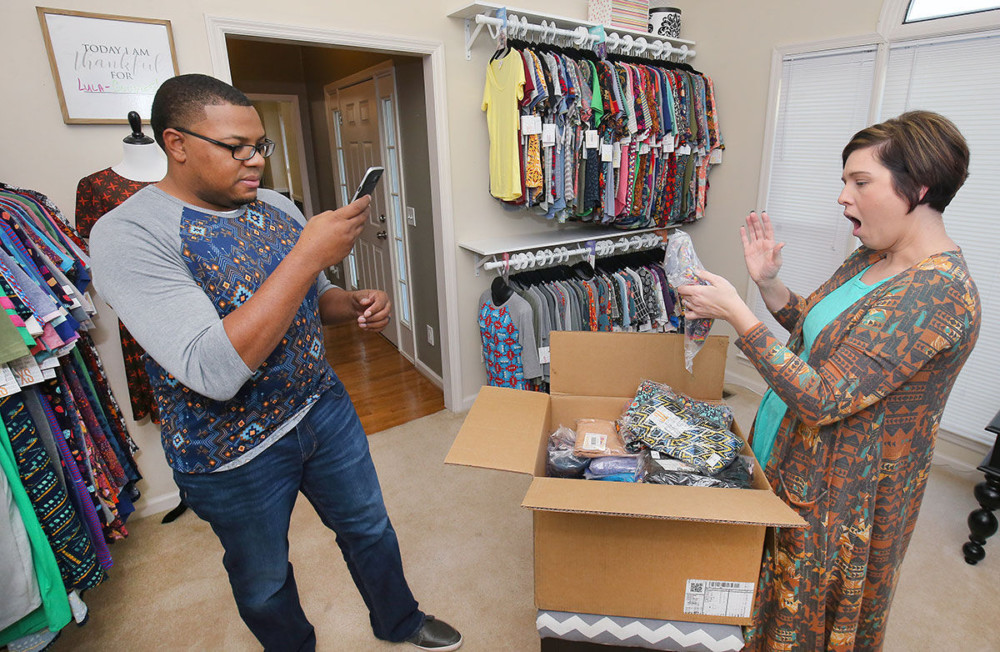By Zach Tyler
The Anniston Star, Ala.
WWR Article Summary (tl;dr) This article takes a look at how one Alabama couple is utilizing livestream videos to virtually sell LuLa Roe clothing. LulaRoe deals almost entirely in women’s clothing. The clothes come in myriad colors and patterns, and one cannot find them inside a brick-and-mortar store anywhere.
The Anniston Star, Ala.
Teachers Adraine and Kasey Scott started their second jobs after 8 p.m. Wednesday night.
With his smartphone broadcasting live video to Facebook from a room in his east Anniston house, Adraine Scott flourished clothing before a camera lens.
“What color would you call this, Kase?” Scott asked, holding aloft a shirt.
“It’s like a teal green,” his wife said from outside the shot.
In the video, which would last a little more than an hour and come to be viewed more than 200 times, Scott waved multicolored leggings, shirts, and skirts before the eyes of virtual shoppers.
The clothes are shipped by the $900 boxload each week to the couple’s home, then unpackaged in a room remodeled to look like the inside of a boutique clothing store.
This happens because Kasey Scott is an independent retailer for LuLaRoe, a company that deals almost entirely in women’s clothing. The clothes come in myriad colors and patterns, and one cannot find them inside a brick-and-mortar store anywhere.
That’s because LuLaRoe relies entirely on direct sales made by independent retailers like the Scotts, who are known as “consultants.”
It’s not clear how many of those there are. Reached by email this week, a LuLaRoe spokeswoman said she couldn’t provide any information about the company.
“We are just not ready to proceed with media yet,” the spokeswoman wrote. The company was founded in 2012, according to information on its Facebook page, and has ridden a meteoric rise in recognition in recent years thanks largely to the efforts of its consultants and the softness of its clothing.
A safe bet might place the number of those consultants in the thousands; a map of them displayed on the company’s website shows a legion of pink dots across the country, a few of them around Anniston.
The company’s model is not dissimilar to other, better-known direct sales schemes, such as Mary Kay. The Scotts both have some experience in those similar efforts, but say LuLaRoe is different.
First, there’s the initial investment. The couple paid about $6,000 for a “starter kit” of clothing and other business supplies — a figure that gave Adraine Scott pause, at first.
Once the clothing arrives, it belongs to the couple. It’s their responsibility to sell it, either online, in their own home, or at “pop-up boutiques” — essentially the Tupperware party of yore, except with leggings.
And if they don’t, Adraine Scott said, they can sell the clothing back to the company — minimizing their risk, he feels.
The couple’s best success so far has come from Facebook, especially the videos they share with a group of shoppers more than 2,000 strong, they said during an interview at their home this week.
Some shop their Facebook page once a month, the couple said. Others buy twice or more each week.
The couple draw their shoppers there by “going live,” a behavior learned by watching other consultants, and now do so multiple times each week. Video isn’t the only way to sell the colorful clothing bought wholesale for about $17 per piece, but consultants like the Scotts share a common bazaar: Facebook.
Efforts this week to reach administrators with the social media giant’s business page weren’t successful, but Facebook seems to view such commercial activity favorably.
As many as 450 million of Facebook’s 1.8 billion users have bought and sold things through the media platform. That was before the company debuted Marketplace last year, a section of its smartphone application intended to formalize those sales.
While more buying, selling or even browsing might not provide a direct benefit to Facebook, it would mean users spending more time on the platform — likely translating into more advertising revenue.
Anniston resident Emily Thomas — the Scotts’ LuLaRoe “sponsor,” — found Facebook posts without video perform well enough to offer a salary comparable to her last job.
Thomas began selling LuLaRoe as a way to spend more time with her family — a 10-year-old daughter, two stepchildren, and her husband. She ships about 400 packages each month now. It’s essentially a full-time job, she said, but worked on her own schedule.
Besides Facebook, the consultants share something else: circumspection when asked how much they make.
Thomas would only say that her income now is comparable to the $60,000 per year she made as a pharmaceutical representative.
She and the Scotts both said they made back what they invested within their first month selling the clothing brand.
Neither worry much about demand slipping. There’s a limited number of each and every pattern the company sends out, they say, which imbues shoppers with the sense of a treasure hunt.
In those early weeks when Adraine Scott saw how much his wife’s new side job was bringing in, he told himself it “had the potential to be something huge.”
Now he’s all in, and enjoys making the live videos. Interacting with the shoppers — which he’s come to view as an extended, albeit lucrative, family — fits his personality.
But reaching the couple’s level of success is “work, it’s not a hobby,” they say. They often stay up until midnight or later each night, invoicing shoppers and shipping skirts and shirts.
They’ve got a goal of selling 1,000 pieces each month. Their current high is 325, but if they reach the goal — that might mean one of them going full-time into LuLaRoe. It could even mean hiring an employee.
At the rate the couple’s side hustle is growing, they’ll meet that goal within a few months. “There’s not much question of that,” Kasey Scott said.














































































































































































































































































































































































